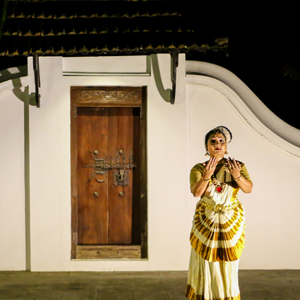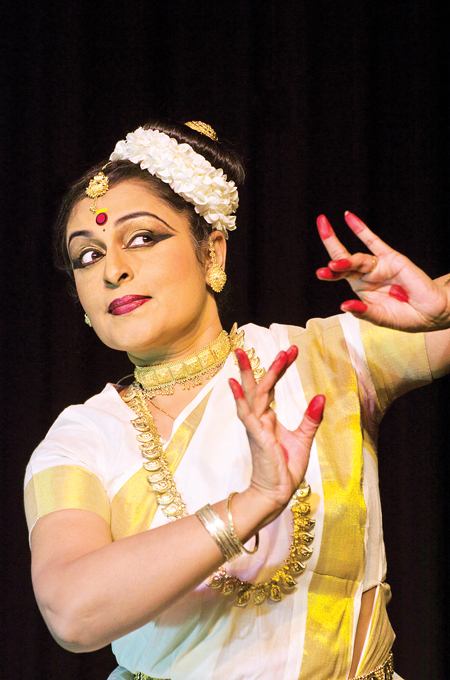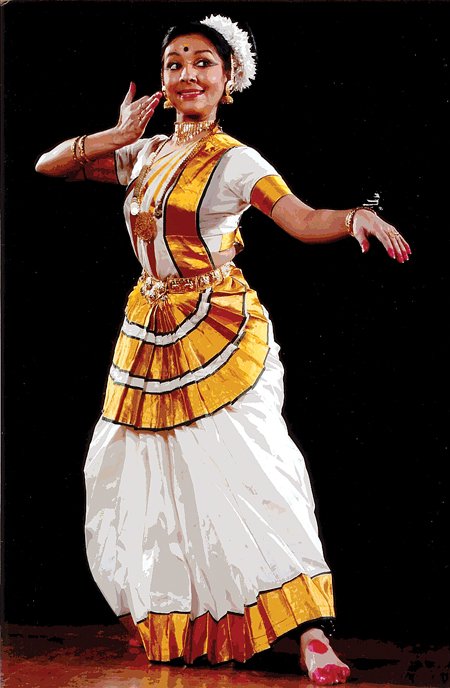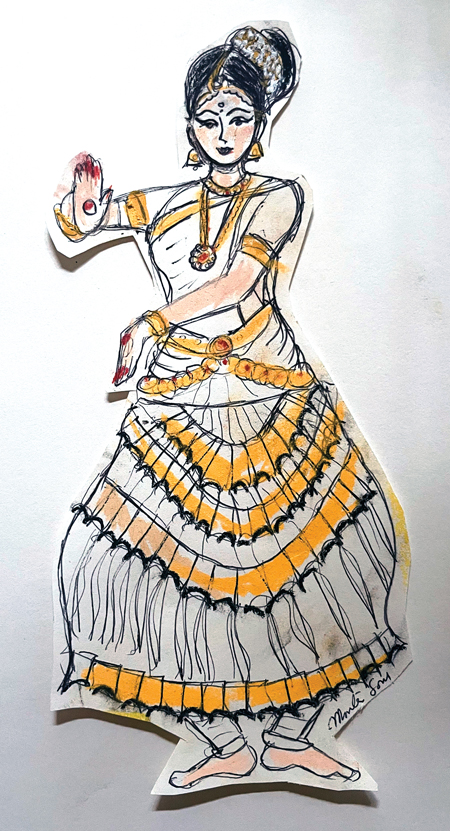Arts: A New Ice Cream Flavor and an Old Dance Form

A casual soiree in her hometown in Alabama takes the author down the memory lane into Kerala, God’s own country, where she was smitten with Mohiniyattam, both in a live performance at a resort as well as its carvings in ancient temples.
[Left] Mohiniyattam follows the 12th-century Lasya subgenre which is a subtle dance performed in Kaisiki Vritti, the feminine, graceful style.
Recently we gathered at our friend’s place and enjoyed homemade snacks, grilled vegetables, watermelon, and corn on the cob. We shared boisterous camaraderie over card games. Our spirits were high, we had consumed a lot of food, but we still craved dessert. My friend offered kulfi, the thickly delicious Indian ice cream, in a flavor called Mohini. What a curious flavor for kulfi, I thought. Common Indian kulfi flavors are Kesar Pista, Malai, Badam, Alphonso Mango, etc. but it’s true that these days similar flavor profiles are marketed with enticing names.
We had a discussion about the meaning of the name Mohini and some words which came to our mind were attraction, seduction, lust. As my friends rattled off, my mind flew on wings of nostalgia to southern India. I recollected the traditional dance, Mohiniyattam, performed for us in the Spice Village resort in Thekkady, Kerala. To my pleasant surprise, it was the same dance form I had seen depicted in the 11th-century Vishnu temple at Thrikodithanam as well as the Kidangur Subramanya temple during that trip.
I do not remember everything about those temples, but sculptures of female dancers in Mohiniyattam dance poses, carved intricately in black stone, appear in my mind’s mirror. Nubile maidens with hair arranged in side chignons adorned with delicately carved jasmine malas. Traditional jewelry with bells rested on their necks, wrists, and ankles.
The name of a spoonful of modern ice cream had plunged me into a beautiful and enriching reverie.
Mohiniyattam is a dance form that originated in Kerala. Attam is a Malayalam word that means rhythmic motion or dance. Mohiniyattam has its roots in Natya Shastra, the ancient Hindu Sanskrit text on performing arts. It follows the 12th-century Lasya subgenre which is a subtle dance performed in Kaisiki Vritti, the feminine, graceful style. This is in contrast to the vigorous, high-energy Tandava dance of Shiva.
In Vyavaharamala, the author Namboodiri elaborates upon the local interest in Mohiniyattam in the 16th century. But the dance form received proper patronage only in the 18th and 19th centuries by princely states. Perhaps the maker of the kulfi flavor Mohini wanted to enlighten this historical nugget of information.
In Indian mythology, Mohini is actually a female form that is the incarnation of the Hindu God, Vishnu. At the beginning of time, during the birthing of the cosmos, there happened to be Sagar Manthan, the churning of the celestial oceans. A vessel of Amrit, the nectar of immortality, was churned out of the Kshira Sagar, the ocean of milk. There was a great tug-of-war between Devas (gods) and Asuras (demons). The demon Bhasmasura ran away with Amrit! To foil his attempt, Vishnu transformed himself into an amazing enchantress and utilized some impressive feminine guile to prevent the destruction of the world, thereby helping good prevail over evil.
[Left] Legend is that, Lord Vishnu transformed himself into Mohini—the enchantress—and utilized some impressive feminine guile to defeat Bhasmasura, the demon. (Photo: Ragamala)
We got a glimpse of such feminine graces when a beautiful young dancer, Nanda, dressed in an off-white traditional Kesavu saree trimmed with gold lace, bowed in front of the small audience at the Spice Village resort. She wore a fitted choli, the blouse, matching the saree. Her waist was cinched with a gold belt where the saree was tucked. The saree fanned out in the front with concentric bands of gold and saffron that afforded freedom of movement and produced an enchanting visual effect as they furled and unfurled. As Nanda struck various evocative poses, her feet and knees were bent, her upper torso was erect, and her body and hips were arranged in a figure of eight—a pose called Atibhanga. Her footwork was dainty as she slid synchronously to the beat of the mridangam and the bansuri. We enjoyed the nritya, the dance performance, which turned out to be an abstract, rhythmic motion with a variety of form, speed, range, and patterns.
Hastha Lakshan Deepika, the ancient Sanskrit classical text on the dances of Kerala, mentions 24 basic mudras or hand gestures that are in use in the classical dance dramas of Kerala. The children especially loved the dancer’s abhinaya, fluent facial expressions and hand gestures, as she articulated the legend and spiritual moral of the story with so much love. Our minds and emotions were both enthralled.
As our plane took off from Thiruvananthapuram airport, I could still hear the dulcet singing of the dancer as she recited the story of Amrit Manthan. I could not read or comprehend Manipravalam, the ancient hybrid Malayalam-Sanskrit language, but Nanda told the story through her expressive kohl-lined eyes. I am glad that she did not have a painted clay mask on like the Kathakali dancers because her smile was most beguiling. My daughter bought a Vishnu mask with a tilak to show her classmates in America. I bought fragrant bags of cardamom and cloves, and a Kerala cotton saree that I treasure to this day.
Not wanting to leave this blissful abode, we peered down at the green land we had left behind. The gentle swaying of the fringed palm trees in the backwaters, and undulating aqua waves reminded me of numerous Mohiniyattam dancers who were banned from performing in ancient Vishnu temples in the early 20th century by the British colonial rulers. Some of them deemed all Indian classical dance forms as nautch! It’s hard to believe that this graceful dance form challenged Victorian morality.
[Right] The author, Monita Soni’s rendering of the art form.
I hope that we remember our Indian history and roots even as we live in America. As we enjoy our friendships in a carefree ambiance, we must pledge to uphold the countless freedoms we take for granted. The freedoms that are eroding before our eyes. It is so important for us to preserve everything we hold dear to our hearts: life, arts, culture, humanities, traditions, and values that make the planet beautiful.
With one foot in Huntsville, Alabama, the other in her birth home India, and a heart steeped in humanity, writing is a contemplative practice for Monita Soni. She has published hundreds of poems, movie reviews, book critiques, and essays; and contributed to combined literary works. You can hear her commentaries on Sundial Writers Corner WLRH 89.3FM and the Princess Theater.
Enjoyed reading Khabar magazine? Subscribe to Khabar and get a full digital copy of this Indian-American community magazine.
blog comments powered by Disqus










